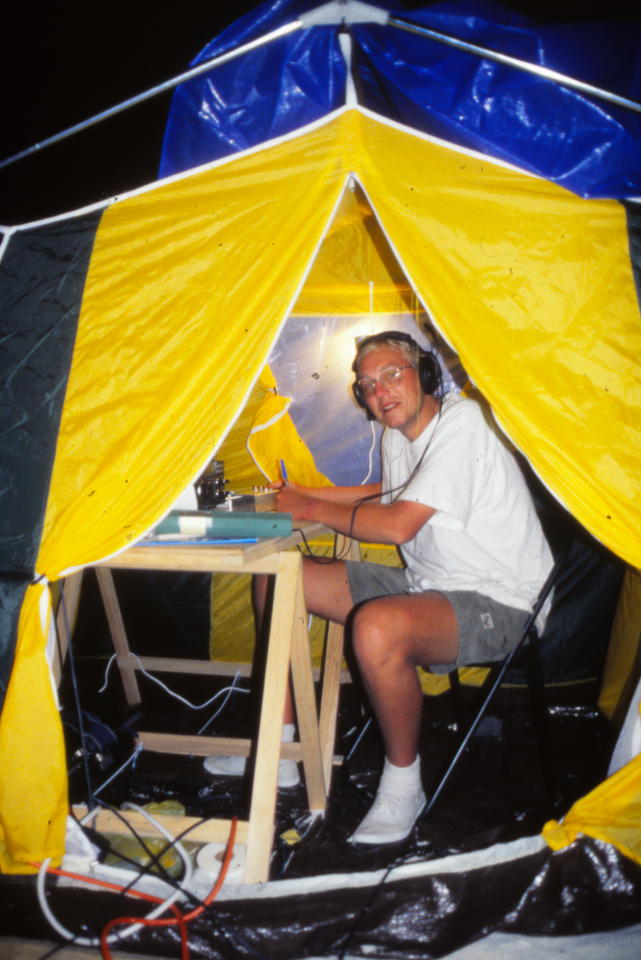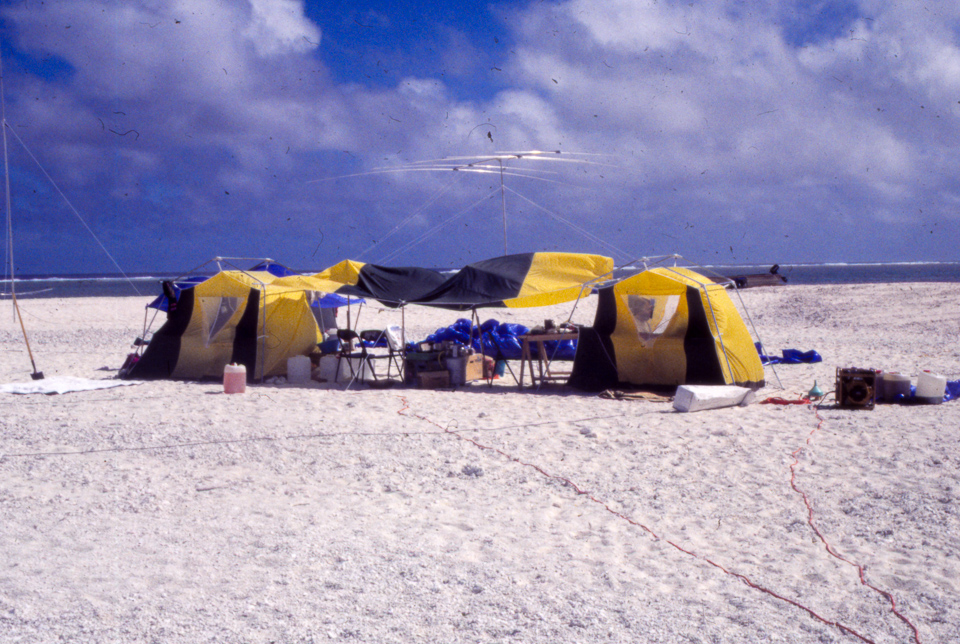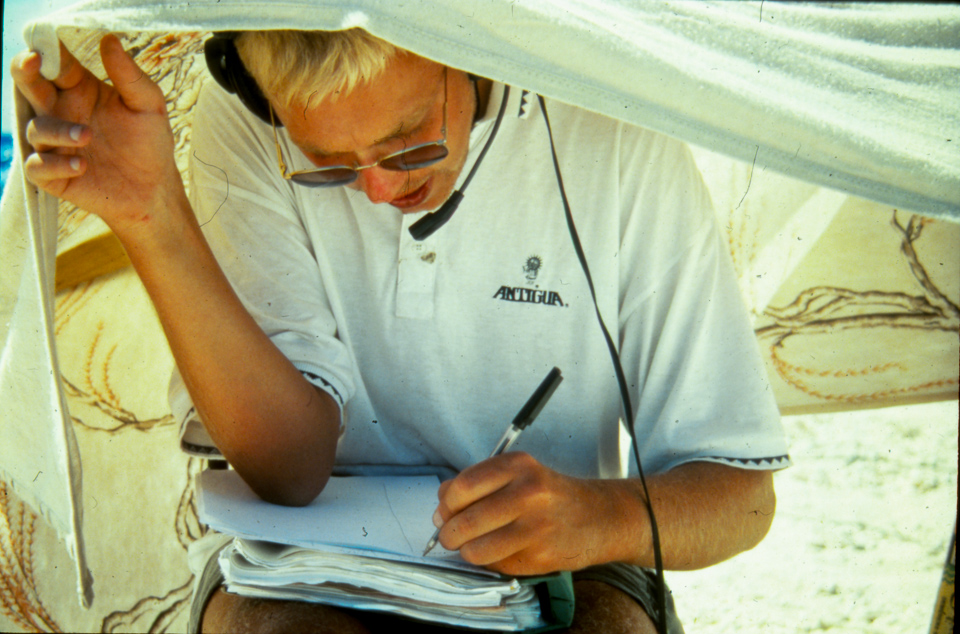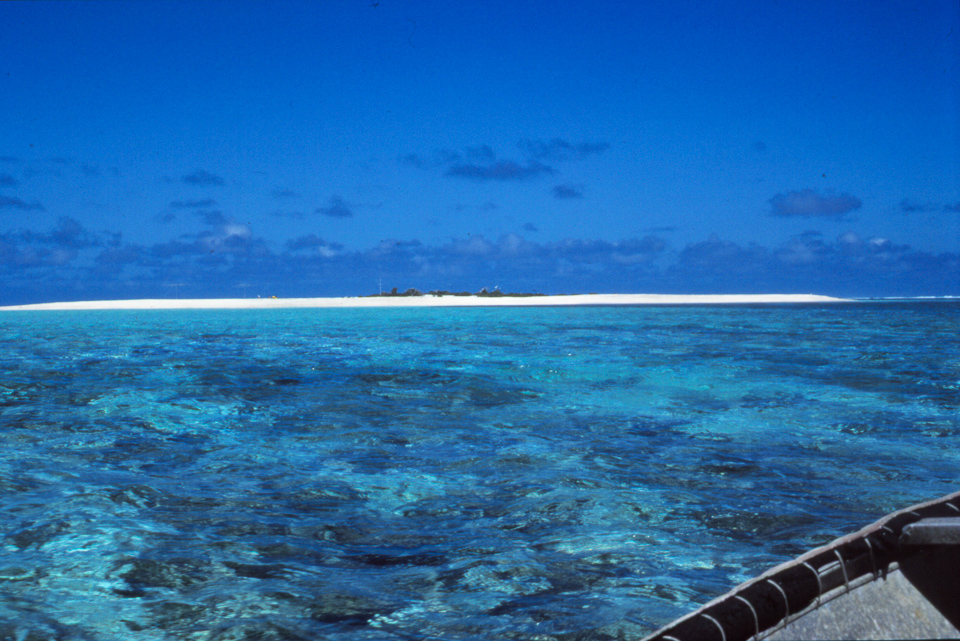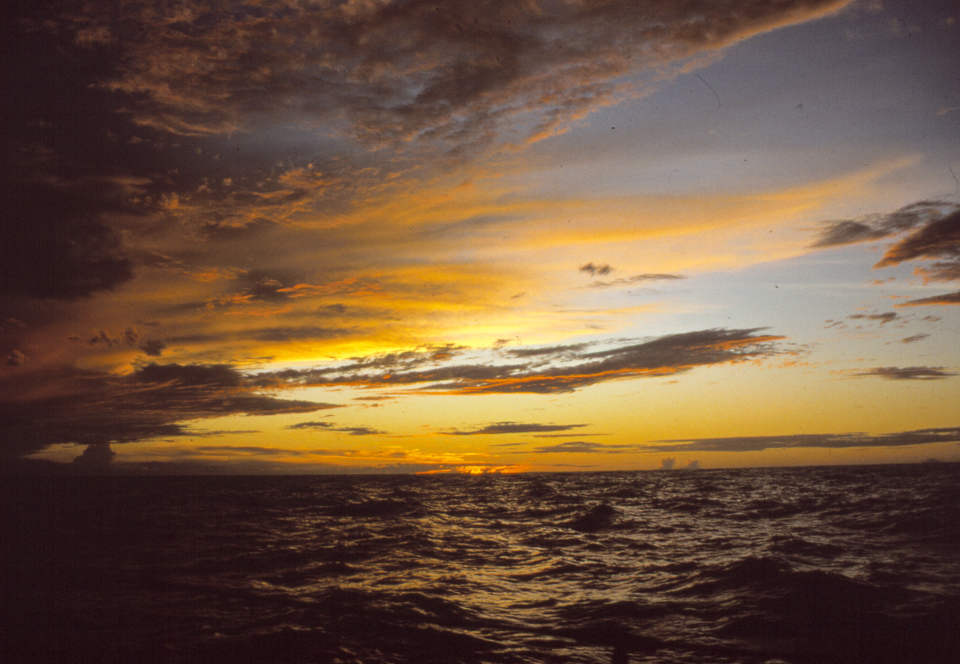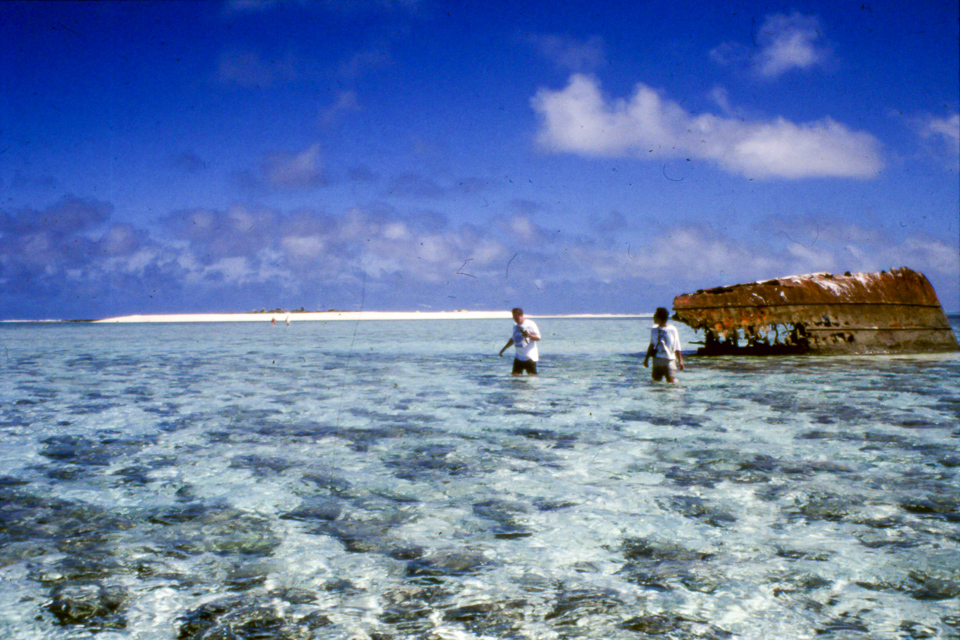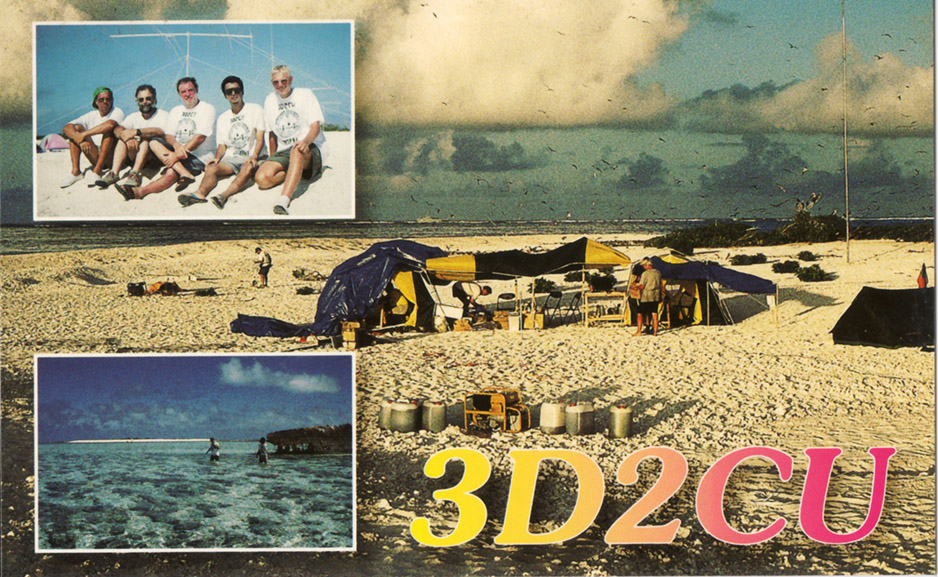
The gang that went to Conway in 1995. From left to right. SM6CAS Nils, NI6T Gary, OH1RY Pekka, JH4RHF Jun and SM7PKK Mats. Infront is the stone showing the claim of Fiji for Conway Reef put on the reef in 1992
The 1995 Conway Reef DX-pedition was a follow up mission to the T33KK/CS DX-pedition which took place in 1994. The intention was actually to visit T31 and ZK3 at this time but we could not find enough people to take a 7 week holiday. As a back up plan we had Conway which by this time had not been activated for 5 years. The real planning for the DX-pedition started some 4 month before the trip when we had to commit the funding for the boat.
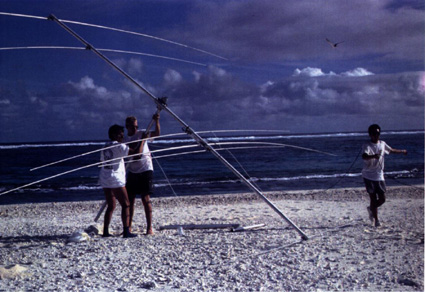
Setting up the Force 12 antennas. Even though we only used 6 meter masts the antennas performed very well.
Our team arrived in the ketch “Te Ni” after 3 days´sail from Suva. While bringing equipment ashore, we capsized two dinghies, loosing critical critical equipment and some of our confidence. Abandonment of the DX-pedition was considered, but in the end we were determined to get on the air. – Even if it meant using only one barefoot station.
After the problem with the first Dinghy turnover we managed to get some items over to the reef. As it was planned we continued to do dinghy rides but since I had been the driver of the dinghy that was overturned we desided to have someone else do the rides. Hoping for better luck if nothing else. As it happened while we where busy building the camp Pekka and Gary had the unfortune of turning another dinghy ride upside down and this ended the dinghy runs the first day. The sun was setting and as we, who where on the reef settled in for the night I found out that all my clothes was completely wet and there was no sleeping bags to crawl into. We had no food but plenty of water so we would not have any problem to survive. The sun went down and I crawled in to my tent. There I was with wet T-shirt and shorts and a plastic tarpolin as the only shelter against the cold. Even though we where in the tropics I can tell you it get’s cold at night even at 20 degrees south. I did not sleep any second the whole night. Just laying there shivering away waiting for the first sunlight to come up. Then you really wonder ” why are we doing this?”
The next morning it took a few hours of daylight before the guys managed to get over to the reef with the dinghy again. The waves had been too high. Finally they came out and I was heading back to the boat, I was wet, tired and generally fed up of the whole thing. I got onboard Te-Ni and there was discussions about cancelling the DX-pedition all together. I was of the same opinion but was not ready to commit to it just yet. The guys cooked me some hot noodles and we sat there discussing. We had some guys convinced we had to abandon the DX-pedition under all circumstances and others who said we needed to push on. Even though the noodles was very basic atleast they gave me the spirit back to fight. We surveyed the damage to the operation and figured that we would be able to set up 2 stations and all the main part of the cooking gear was still ok for us to actually go ahead. So in the afternoon we desided we where still on a go. Although we lost two days´, no more accidents occured, and we eventually put 2 stations on the air.
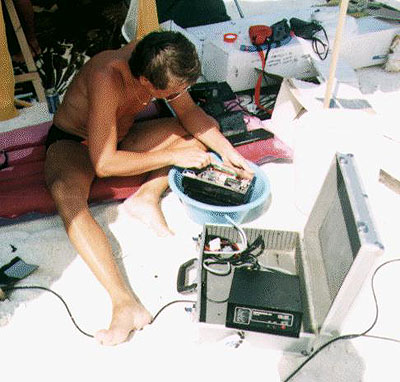
One of the casualties of the turnover dinghy’s was Pekkas newly designed 1KW FET Amplifier. He cleaned it out but the Amp could not work. We soaked a Kenwood power supply in fresh water and dried it out and it actually worked afterwards!
After 3 days of operation I was still thinking if there was a way to get one more radio on the air, even if it was without an amplifier. We had no powersupply and no more amp so we had to improvise. I asked the guys to bring over a 12 V battery from the boat as I thought we should be able to use it as a the powersource for the third radio while charging it direclty from the generator, since one of them had a 12 volt outlet. So it happened.
I took a chair and the radio and went out to the generator and connected my station. Sitting 3 meters away from the generator in the middle of the sun I was starting to work pileups on the WARC bands. I made about 500 QSO’s in the afternoon sitting out there while Gary and Jun started building a sun shelter for me. We continued to use this station during daytime but we rearranged the generators so we could keep the radio in the kitchen area.

The tent on the left is was the SSB/RTTY site and the one on the right was the CW site. In between the tents there is a shaded area which housed the3rd operating position and the kitchen.
We made almost 30,000 QSO´s on 9 bands and 3 modes in 7 full days of operation. While the SSB stations had a working amplifier, the two CW/RTTY stations experienced amplifier problems and operated barefoot most of the time.
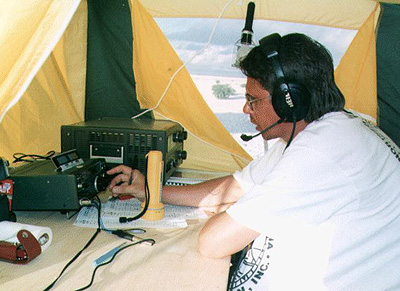
Pekka running a pileup, the TL-922 was a workhorse and had no problem with the power fluctuation we faced full time
The propagation was a bit wild since we had superb connections to EU while wher still on the boat. once we arrived on the reef we had basically lost all propagation to EU the first few days and then it recovered a bit . We never did experience the same signal levels though as we had as Maritime mobile.

The SSB and CW antennas C3XL spread out as wide as we could and the N1217 WARC band antenna in the middle. The antennas performed superbly and having a trapless configuration really helped limit the interference between the stations.
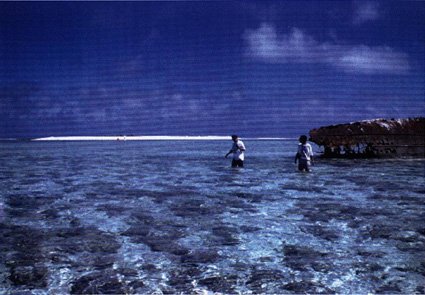
Finding time to walk on the reef. Once the tide start coming in it is best to hurry up or it is very easy to get caught by the waves.
Conway Reef or Ceva-I-Ra to the Fijians – is a treeless, waterless, coral cay 50 by 200 m at high tide, 300 miles SW of Suva, Fiji. Although tiny, it is of major economic importance to Fiji, as it defines the southern limits of its Economic Zone. The primary inhabitants are birds and hermit- crabs. The fringing reef, combined with the current and wind, creates a treacherous surf and dangerous landing conditions.
